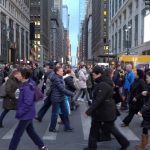Students at Syracuse University will now be able to use a hand scanner to gain access to the school’s dining centers, which the school says will “facilitate a quicker, contactless entrance at mealtimes.”
Alabama Governor Kay Ivey announced that the state is launching the Alabama Credential Registry, which she says is “first in a series of technology solutions that will implement Alabama’s talent development system.”
In just a few short weeks, the crème de la crème of state IT dominions will gather for their first in-person event in 24 months. The National Association of State Chief Information Officers (NASCIO) will convene their annual conference October 10-13 in Seattle. In addition to the 50 or so state CIOs, another 100 senior state and local government IT officials, and several hundred members of the state IT vendor community will join the gathering for lofty rhetoric; best practices recapitulation; diversity, equity, and inclusion (DEI) sessions; and a major opportunity for networking.
The Federal Communications Commission (FCC) announced that it committed more than $1.2 billion in funding to ensure that more than 3.6 million students have access to broadband and devices needed to engage in off-campus learning.
As an unprecedented number of employees continue to work on-site and remotely, ensuring the proper rollout of the latest IT infrastructure is crucial in securing networks and ensuring operational success. However, various state and local agencies faced challenges in attempting to aid employees in this new work environment, said Rohit Tandon, assistant commissioner and the state chief information security officer for the state of Minnesota, on September 23 during a Nextgov webinar.
Many school districts across the nation expanded efforts to provide students with laptops and tablets to help them succeed in the virtual classroom; this effort included introducing student activity monitoring software aimed in part at facilitating remote classroom management and driving student engagement. However, according to a recent report by the Center for Democracy and Technology (CDT), these tools can become overly intrusive.
Bloomberg Philanthropies and the U.S. Conference of Mayors have launched a new resource to help mayors across the country identify, obtain, and retain billions in Federal COVID-19 recovery funding.
As a result of the COVID-19 pandemic, new research from the National Council for State Authorization Reciprocity Agreements (NC-SARA) found that distance education enrollment increased 93 percent over Fall 2019 enrollments.
Miami Dade College (MDC) appointed Tanya Acevedo the new vice president for Information Technology and chief information officer (CIO).
A new agreement led by the Commonwealth of Massachusetts will allow eight neighboring states and Washington, D.C., to offer Internet access, devices, and other technology to constituents through local agencies at a discounted rate via Verizon’s Digital Inclusion Program.












